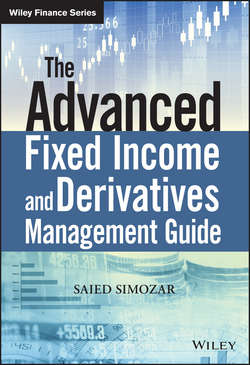Читать книгу The Advanced Fixed Income and Derivatives Management Guide - Saied Simozar - Страница 16
На сайте Литреса книга снята с продажи.
Chapter 2
Term Structure of Rates
ОглавлениеIn the previous chapter, we briefly discussed some of the shortcomings of the traditional measurements of risk and return in the treasury markets. Analysis of more complex fixed income instruments such as options and futures, credit products and mortgages requires more elaborate mathematical analysis and cannot be handled using the simple price/yield formulas. As we discussed previously, the result of yield or duration calculation of a portfolio was path dependent, that is, the calculated yield and duration were different if we treated all cash flows as one security or calculated the yield and duration for each cash flow separately and then combined the results. The primary reason for this path dependency was the use of different discount yields in one path versus another. Our primary objective in this chapter is to develop a term structure of interest rates (TSIR) model that provides a basis for discounting all cash flows at the correct discount yield. We will then provide examples of market derived yield curves based on our methodology.
2.1 LINEAR AND NON-LINEAR SPACE
Perhaps the most important issue in developing a TSIR model is the choice of reference frame. To motivate the development of a logical reference frame, we will compare an investment instrument to a pedestrian.
Consider a fixed income instrument that pays or receives a constant cash flow of c at regular intervals such as a fixed rate bond or a home mortgage loan. Likewise, consider a pedestrian who walks with a uniform step size of c. After n steps, the sum of cash flows or the traveled distance for the pedestrian is
2.1
Since long term cash flows are worth less than near term ones, the value of cash flows is different from the sum of cash flows. Using a continuous compounding method, we can calculate the present value of cash flows discounted by a yield of y as
2.2
Equations (2.1) and (2.2) are examples of discrete processes. We can also write equivalent equations in a continuous form. If the pedestrian walks at a speed of v per unit of time or a fixed income instrument has a cash flow of v per unit of time, we can write (2.1) as either
2.3
or
2.4
Likewise, (2.2) can be written as
2.5
Equation (2.4) is the integral form of (2.3); for our example (2.3) and (2.4) are identical. The most important difference between (2.4) and (2.5) is that (2.4) is linear and (2.5) is non-linear (exponentially decaying). The marginal value of a step in the linear case is the same whether it is at the beginning of the walk process or at the end of it. On the other hand, the marginal value of a cash flow in the future is less than the present cash flow.
Let us define the function u as
2.6
so that
2.7
By substituting the integrand in (2.5) using (2.7), we have
Конец ознакомительного фрагмента. Купить книгу
